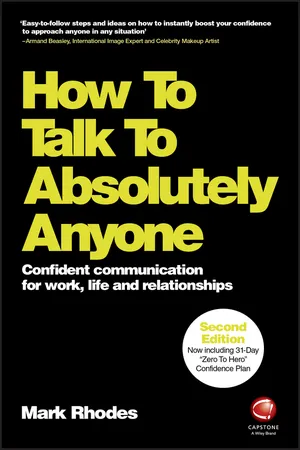
How To Talk To Absolutely Anyone
Confident Communication for Work, Life and Relationships
- English
- ePUB (mobile friendly)
- Available on iOS & Android
How To Talk To Absolutely Anyone
Confident Communication for Work, Life and Relationships
About this book
How to Talk to Absolutely Anyone is your personal handbook for stepping up your communication game. Part confidence coach and part social manual, this book reveals the reasons behind your reserve and offers real, practical ways to break through the barriers and make a connection. Whether you fear judgement and rejection or just don't know what to say, these simple exercises will equip you with a gold mine of social tools to get you through any situation. This new second edition has been updated to include the complete 30-day Zero to Hero Personal Confidence Course, to help you build your skills and increase your chances of getting what you want out of any conversation. Working step-by-step, you'll learn how to approach strangers, strike up a conversation and exit gracefully; by first changing your outlook, you develop the ability to navigate even tricky situations with confidence and ease.
Conversation skills affect more than your social life — they can impact your career as well. In removing your social hesitance, you open up a whole new world of effective communication with customers and colleagues, and begin building the relationships that get you closer to your goals. This book provides real-world techniques to help you get better and better every day, enabling you to:
- Overcome your fear of rejection.
- Strike up a conversation with anyone, anywhere.
- Open up to make real connections and build strong rapport.
- Carry your confidence into networking, sales and more.
Leave the days of awkwardness behind you. Stop running away from uncomfortable interactions and start getting comfortable instead. Whether you need to close the deal, build contacts or just make small talk at a party, How to Talk to Absolutely Anyone helps you build the confidence and skills you need to talk your way to success.
Frequently asked questions
- Essential is ideal for learners and professionals who enjoy exploring a wide range of subjects. Access the Essential Library with 800,000+ trusted titles and best-sellers across business, personal growth, and the humanities. Includes unlimited reading time and Standard Read Aloud voice.
- Complete: Perfect for advanced learners and researchers needing full, unrestricted access. Unlock 1.4M+ books across hundreds of subjects, including academic and specialized titles. The Complete Plan also includes advanced features like Premium Read Aloud and Research Assistant.
Please note we cannot support devices running on iOS 13 and Android 7 or earlier. Learn more about using the app.
Information
PART ONE
Common Fears and Barriers about Talking to Absolutely Anyone
1
Fear – Does It Hold You Back?
What Exactly Is Fear?
How much fear do you have?
Let go of your fear
- Remember the last time you were in the situation that you fear.
- Visualize in your mind what you saw at that time.
- Imagine you can hear any sounds you heard or things you remember people saying or you said to yourself.
- Ask yourself – “How much fear did I have in that situation on a scale of 0–10?”
- Go somewhere where there are lots of people around.
- Tell yourself you are going to force yourself to speak to someone.
- Think of something to say or a question to ask – even “Have you got the time please?”
- Start to walk in their direction.
- Speak to them.
Fear and anxiety
Ways to reduce your fear or push on rega...
Table of contents
- Cover
- Title Page
- Table of Contents
- About the Author
- Foreword by Armand Beasley
- Introduction: Why You Should Want to Talk to Absolutely Anyone
- PART ONE: Common Fears and Barriers about Talking to Absolutely Anyone
- PART TWO: The Four Stages of an Interaction
- PART THREE: Making Your Communication Even Better
- PART FOUR: 31 Day “Zero To Hero” Talk To Absolutely Anyone Plan
- Blog Articles and YouTube
- Index
- End User License Agreement